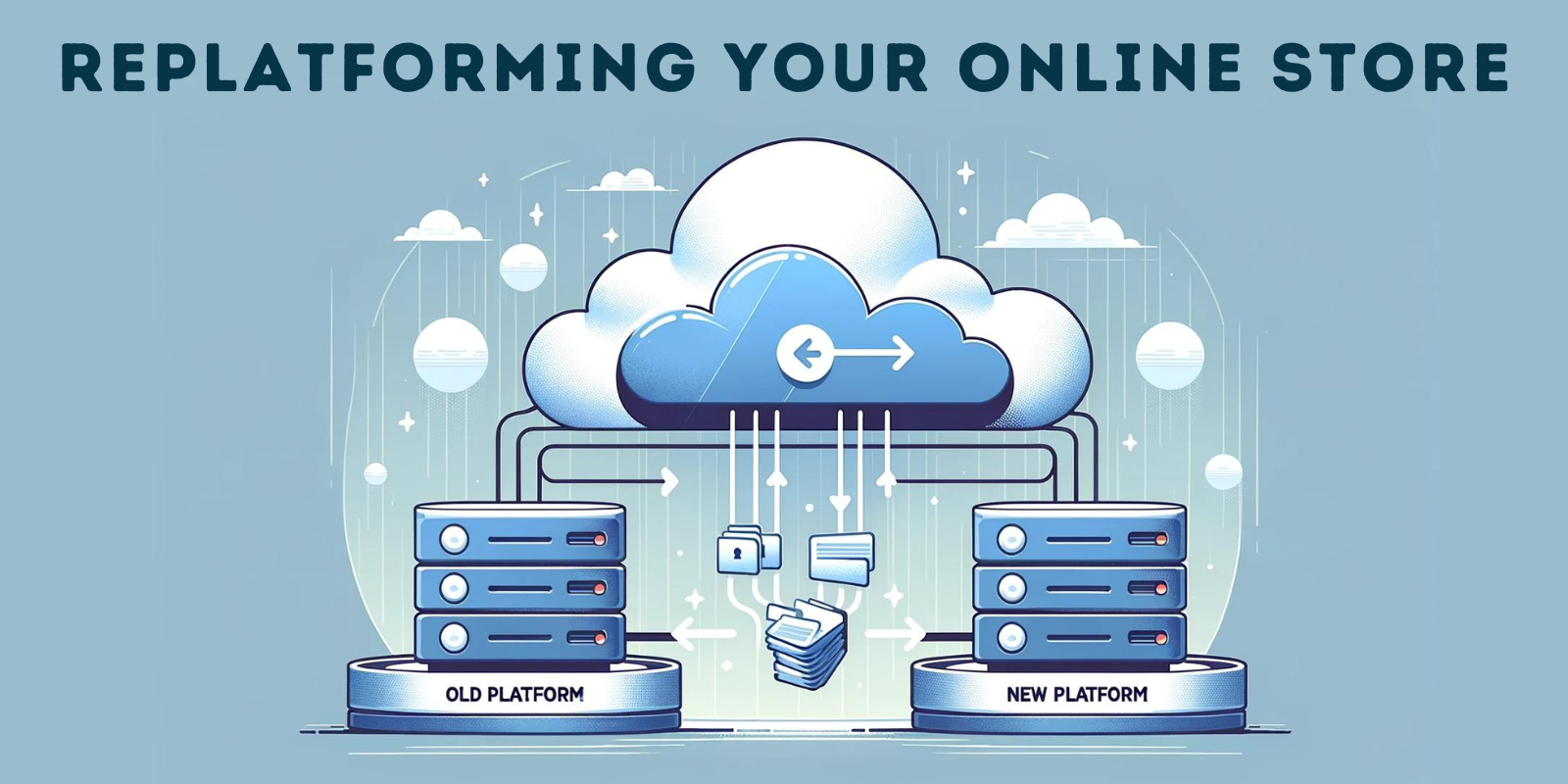
Ecommerce Site Migration
The Ultimate Guide to Replatforming Your Online Store
Considering ecommerce migration for your online store? You’re not alone. Ecommerce migration is the pivotal process of moving your digital storefront to a new platform that better suits your evolving business needs. This strategic step is fundamental for enhancing performance, and integration capabilities, and ensuring scalability for future growth. Our comprehensive guide provides a strategic approach to re-platforming, comparing popular platforms, and outlining key steps to guarantee a smooth transition – all while keeping your SEO and customer experience intact.
Key Takeaways
- Ecommerce migration is a strategic decision to enhance an online store’s performance, providing benefits such as improved operations, reduced costs, and bolstered SEO—facilitating future growth and competitiveness.
- Choosing the right new ecommerce platform involves assessing features, security, scalability, user experience, return on investment, and the platform’s ability to integrate with other business tools like payment gateways and accounting software.
- Ecommerce replatforming requires a detailed plan addressing design continuity, data integrity and migration, setup on the new platform, SEO preservation through 301 redirects, integration of essential apps, overcoming common migration hurdles, and continuous post-migration monitoring and optimization.
Critical Components of an Ecommerce Migration
Ecommerce migration is more than a simple switch from one system to another. It’s a strategic move aimed at enhancing your online store’s performance, capabilities, and usability. Perhaps your current ecommerce platform is outdated, or it’s burdened with excessive maintenance costs. Maybe it lacks essential features or integrations that could propel your online business to the next level. These challenges can be overcome with a successful ecommerce migration.
Ecommerce migration is not just about addressing present issues. It’s about paving the way for future growth and competitiveness. As the online market evolves, so do customer demands and expectations migrating ecommerce platforms. A successful ecommerce migration helps businesses stay ahead of the curve, providing a robust platform primed for expansion.
The benefits of a successful ecommerce top migration strategy, while considering the ecommerce site migration cost, are:
- Streamlining operations
- Reducing costs
- Enhancing SEO capabilities
- Providing better analytics
- Significantly improving site performance
In a nutshell, ecommerce migration is a key step towards optimizing your online store for success.

The Strategic Approach to Selecting Your New Ecommerce Platform
Choosing the right ecommerce platform for your business is a strategic decision that goes beyond comparing price tags. It requires a comprehensive assessment of the platform’s features, security, scalability, and user experience, keeping in line with your business goals. The market is teeming with a variety of ecommerce solutions, each with its unique strengths. Among them, SaaS providers like Shopify and BigCommerce stand out for their efficiency and comprehensive support, particularly for businesses with limited resources.
While considering the total cost of ownership is essential, it’s equally important to ensure that the chosen ecommerce platform offers a return on investment. A platform that allows for significant customization can offer a tailored business fit, enabling you to mold your online store according to your unique business needs. Let’s delve deeper into assessing platform features and comparing popular choices like Shopify and BigCommerce.
Assessing Platform Features
Every ecommerce platform comes with a unique set of features. However, there are some key ones that every ecommerce business should consider. Some of these include:
- A responsive design, which offers a seamless user experience across desktops and mobiles
- Easy-to-use navigation and search functionality
- Secure payment gateways to protect customer information
- Inventory management tools to track and manage product stock
- Marketing and promotional features, such as discount codes and email marketing integration
- Integration with popular shipping carriers for easy order fulfillment
- Analytics and reporting tools to track sales and customer behavior
These features are essential for running a successful ecommerce business.
Integrations with critical business operations tools are another crucial aspect to consider. Payment gateways, accounting tools, email marketing tools – these are just some of the integrations that an ecommerce platform should support to facilitate smooth day-to-day operations. Customization, too, is vital. Whether you’re adapting existing site templates or creating personalized designs, a platform that allows for a customized user experience can make a huge difference.
Finally, scalability and security are key features that cannot be overlooked on premise solutions. The platform should be capable of handling a large number of SKUs and multiple warehouses, ensuring it can support your business as it grows. It must also offer robust security features to provide a trusted shopping environment for your customers.
Last but not least, excellent technical support is crucial to address any potential issues promptly, ensuring minimal disruption to your customers.
Comparing Shopify and BigCommerce
Shopify and BigCommerce are two popular choices when it comes to ecommerce platforms. Offering different pricing and features, these platforms cater to a range of business needs. Shopify, for instance, offers scalable features and add-ons, with pricing tiers ranging from $9 to $299 per month. This makes it a suitable choice for ecommerce businesses of all sizes, from small startups to large enterprises.
On the other hand, BigCommerce, with pricing from $29.95 to $249.95 per month, stands out for its SEO benefits. Businesses focused on organic growth might find BigCommerce more appealing due to its advanced SEO capabilities.
The choice between Shopify and BigCommerce ultimately comes down to your specific business needs and goals. Assessing the features, pricing, and scalability of each platform can help you make an informed decision that aligns with your business strategy.

Crafting a Blueprint for Seamless Ecommerce Replatforming
Ecommerce migration, which includes the crucial aspect of ecommerce data migration, is not a one-step process; it involves a series of steps that require meticulous planning and execution. Prior to migration, it’s important to outline a detailed ecommerce migration plan and create an ecommerce data migration process checklist that aligns with your core business requirements, complete with clear goals.
The steps involved in the ecommerce replatforming process are manifold, including:
- Defining the project scope
- Designing the user experience
- Migrating existing data
- Optimizing for search engines
- Integrating systems
- Conducting user acceptance tests
Each step is crucial to ensure a smooth and successful transition for existing customers to the new platform. Let’s break down these steps further.
Design Continuity and Branding
Design continuity is a crucial aspect of ecommerce migration. Having the design for the new site ready before migrating can ensure a smooth transition. This design should be set up on a staging site to test for continuity and functionality.
Testing the new design on a staging site is also essential to maintain the integrity of your brand throughout the migration process. This step allows you to catch any inconsistencies or errors before they affect your customers, ensuring a seamless user experience.
Data Integrity and Migration
Data integrity is a critical aspect of ecommerce migration. The ETL (Extract, Transform, Load) process, which involves extracting customer data from from the old platform, transforming it into a format compatible with the new platform, and then loading it onto the new platform, requires careful planning to ensure a smooth transition. Data migration services play a crucial role in this process.
Tools such as Shopify’s Store Importer and various data migration applications can facilitate the transfer of products, customers, and order histories. However, ensuring data security during this process is paramount. Risks such as data loss, hacking, and leaks must be addressed with stringent data security measures and loss prevention practices.
To ensure minimal downtime and data accuracy, migration is often tackled in stages, each tested before full commitment. Consultation with experts can help in a cost-effective transfer, while careful organization of content guarantees completeness and accuracy.
Setting Up Shop on the New Platform
Setting up shop on the new platform is more than just a copy-paste job. It involves identifying the technologies and integrations currently in use and determining which components need to be migrated and which can be discarded.
Once the necessary components have been identified, it’s time to plan the website launch. This involves:
- Creating a launch checklist
- Choosing the least disruptive timing for customers
- Collaborating with an agency or solutions partner for a smooth transition.
Testing is a critical part of setting up shop on the new platform. From site navigation to checkout experience, every aspect of the site needs to be tested thoroughly to ensure optimal functionality.
After the site goes live, it’s important to keep a backup of the old site to resolve any issues with missing elements on the new platform. Regular reviews of the staging versus the live site can help identify and rectify any discrepancies, ensuring a consistent experience for your customers.

Mastering 301 Redirects: Safeguarding Your SEO Investment
SEO is a critical aspect of ecommerce, and during migration, it’s important to preserve your search engine rankings. This is where 301 redirects come in. These redirects inform search engines that a webpage has not been deleted, thus helping to preserve your rankings.
An improper migration can temporarily impact your search engine rankings, but this setback can be mitigated with correct implementation of 301 redirects. A thorough redirect plan should be formed before the migration, mapping every URL to ensure a seamless transition and to reduce the risk of broken links.
Remember, 301 redirects are not just about preserving your SEO rankings. They also play a critical role in maintaining customer continuity and accessibility. A 301 redirect guides users from an outdated web address to the current online store, ensuring a seamless shopping experience for your customers.
Tailoring Your Store with Essential Apps and Integrations
Identifying and integrating essential apps and third-party tools is a crucial part of creating an efficient ecommerce store. Prior to migration, it’s important to identify the necessary integrations, functions, and third-party apps that will be part of your new online ecommerce store migration move.
Third-party apps, APIs, and integrations can facilitate seamless workflows and cost-effective automation features, making them vital for ecommerce companies and store owners. However, integrating new third-party tools can present challenges during ecommerce migration, sometimes necessitating additional development work for an effective ecommerce solution.
One of the major benefits of third-party integrations is the ability to enable multi-channel selling. By integrating your store with various channels such as various social media platforms and online marketplaces, you can significantly increase your revenue potential.
Overcoming Common Hurdles in Ecommerce Platform Migration
Ecommerce migrations can be complex and challenging, earning them a somewhat negative reputation. However, with careful planning and preparation, these hurdles can be overcome. For instance, enhanced staff training on the new platform’s workflow can help ensure a smooth transition.
Incompatibility challenges with old plugins and the need for suitable new integrations can pose additional hurdles. However, these can be resolved with careful planning and the right technical expertise. Email systems hosted on the old platform server also require careful attention. Here are the steps to follow:
- Thoroughly backup contacts and messages from the old email system.
- Set up the new email system.
- Establish mail forwarding from the old email system to the new one.
Anticipating potential problems and being prepared for ecommerce migration challenges is pivotal to ensuring the process is successful and efficient.
We can help with your migration
We help with ecommerce site migrations to BigCommerce and Shopify all the time, including both look and feed, as well as data migration and platform consulting. Some of the most common to Shopify include Magento to Shopify, WooCommerce to Shopify and BigCommerce to Shopify. Likeways we help with Magento to BigCommerce, WooCommerce to BigCommerce and Shopify to BigCommerce.
Post-Migration: Monitoring and Optimizing Your New Ecommerce Site
After migration, the work isn’t over. Continuous monitoring of the new ecommerce site for 1-2 months is essential to promptly address any traffic drops or indexing issues. Google Analytics and Search Console are key tools for reviewing post-launch site performance to verify precise tracking and indexing.
Post-migration, it’s also important to analyze customer behaviors on the current solution and the new site. This can help you optimize the site for improved conversion rates. Both internal stakeholders and loyal customers should be involved in this analysis to gain comprehensive insights.
Lastly, you should conduct a site speed test using tools like Google PageSpeed Insights to confirm that all pages are operating optimally post-migration. Completing various post-migration tasks is critical for maintaining site performance and customer satisfaction.
Engaging Epic Design Labs for Expert Ecommerce Migration Support
Ecommerce migration can be a daunting process, especially for businesses that lack the technical expertise. This is where Epic Design Labs steps in. With over fifteen years of experience, Epic Design Labs offers comprehensive ecommerce website design and development services, tailored to store owners looking to migrate data bolster their online presence on ecommerce sites.
Engaging a professional agency like Epic Design Labs can ensure a smooth and efficient ecommerce migration process. They can handle the entire process, from planning and execution to post-migration support, ensuring that your specific vision for your online store is realized.
Some of the most common migrations we do include Magento to BigCommerce, Shopify to BigCommerce, WooCommerce to BigCommerce.
Engaging Epic Design Labs not only provides expert support but also helps realize the specific vision store owners have for their own ecommerce stores and platforms during and after the migration. So, whether you’re just starting out or looking to scale your ecommerce business, Epic Design Labs is ready to assist you on your journey.
Summary
Ecommerce migration is a strategic move aimed at enhancing your online store’s performance, capabilities, and usability. From selecting the right ecommerce platform migrations, to ensuring design continuity, data integrity, and SEO optimization, every step plays a critical role in a successful ecommerce migration. Despite the challenges, with careful planning, expert support, and continuous post-migration monitoring and optimization, businesses can ensure a smooth and efficient transition to a new ecommerce platform.
The journey might seem daunting, but with the right partner by your side, it can be a transformative experience for your business. As the online market evolves, so should your business. Ecommerce migration is not just about addressing present issues; it’s about paving the way for future growth and competitiveness. After all, in the dynamic world of ecommerce, the art of adaptation is crucial.
Frequently Asked Questions
What is the next generation of ecommerce?
The next generation of ecommerce will be shaped by technologies such as artificial intelligence (AI), which will offer personalized shopping experiences, engaging customer service, and improved supply chain logistics. Livestream shopping, voice commerce, and other innovative formats are also expected to play a significant role in the future of ecommerce.
How do I migrate my ecommerce website?
To migrate your ecommerce website, you need to carefully plan the process, redesign and develop the website, optimize the checkout, audit for SEO, check everything, and then launch the new website. Follow these steps to ensure a successful migration without any hassle.
Why is ecommerce migration important?
Ecommerce migration is important because it helps businesses stay competitive in the online market, meet customer demands, and ensure a strong foundation for future growth.
What are the key considerations when creating an ecommerce migration plan?
When creating an ecommerce migration plan, it is crucial to define clear objectives and goals for phased migration, conduct a comprehensive audit, create a detailed timeline with milestones, and carefully select a suitable platform to ensure a successful migration. These considerations will help in planning and executing a smooth transition to a new ecommerce platform.
What is ecommerce migration?
E-commerce migration is the process of moving your existing online store from one platform to another, with the goal of improving performance and leveraging current platform more advanced features (Yahoo, 2021).
